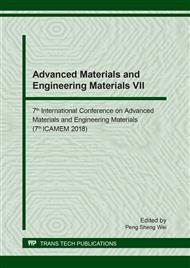[1]
W. Wu, S. Hu, J. Shen, Microstructure, mechanical properties and corrosion behavior of laser welded dissimilar joints between ferritic stainless steel and carbon steel, Materials & Design 65 (2015) 855-861.
DOI: 10.1016/j.matdes.2014.09.064
Google Scholar
[2]
K. Kimapong, T. Watanabe, Lap Joint of A5083 Aluminum Alloy and SS400 Steel by Friction Stir Welding, Materials Transactions 46 (2005) 835-841.
DOI: 10.2320/matertrans.46.835
Google Scholar
[3]
H. Dong, C. Liao, L. Yang, C. Dong, Effects of post-weld heat treatment on dissimilar metal joint between aluminum alloy and stainless steel, Materials Science and Engineering: A 550 (2012) 423-428.
DOI: 10.1016/j.msea.2012.04.110
Google Scholar
[4]
N. Arivazhagan, S. Singh, S. Prakash, G. M. Reddy, Investigation on AISI 304 austenitic stainless steel to AISI 4140 low alloy steel dissimilar joints by gas tungsten arc, electron beam and friction welding, Materials & Design 32 (2011) 3036-3050.
DOI: 10.1016/j.matdes.2011.01.037
Google Scholar
[5]
R. Paventhan, P. R. Lakshminarayanan, V. Balasubramanian, Fatigue behaviour of friction welded medium carbon steel and austenitic stainless steel dissimilar joints, Materials & Design, 32 (2011) 1888-1894.
DOI: 10.1016/j.matdes.2010.12.011
Google Scholar
[6]
C. R. Das, A. K. Bhaduri, G. Srinivasan, V. Shankar, S. Mathew, Selection of filler wire for and effect of auto tempering on the mechanical properties of dissimilar metal joint between 403 and 304L(N) stainless steels, Journal of Materials Processing Technology 209 (2009).
DOI: 10.1016/j.jmatprotec.2008.03.053
Google Scholar
[7]
M. Jafarzadegan, A. Abdollah-zadeh, A. H. Feng, T. Saeid, J. Shen, H. Assadi, Microstructure and Mechanical Properties of a Dissimilar Friction Stir Weld between Austenitic Stainless Steel and Low Carbon Steel, Journal of Materials Science & Technology 29 (2013).
DOI: 10.1016/j.jmst.2013.02.008
Google Scholar
[8]
R. Kaçar, O. Baylan, An investigation of microstructure/property relationships in dissimilar welds between martensitic and austenitic stainless steels, Materials & Design, 25 (2004) 317-329.
DOI: 10.1016/j.matdes.2003.10.010
Google Scholar
[9]
S. Wang, Q. Ma, Y. Li, Characterization of microstructure, mechanical properties and corrosion resistance of dissimilar welded joint between 2205 duplex stainless steel and 16MnR, Materials & Design 32 (2011) 831-837.
DOI: 10.1016/j.matdes.2010.07.012
Google Scholar
[10]
M. J. Torkamany, J. Sabbaghzadeh, M. J. Hamedi, Effect of laser welding mode on the microstructure and mechanical performance of dissimilar laser spot welds between low carbon and austenitic stainless steels, Materials & Design 34 (2012) 666-672.
DOI: 10.1016/j.matdes.2011.05.024
Google Scholar
[11]
M. N. Esfahani, J. Coupland, S. Marimuthu, Microstructure and mechanical properties of a laser welded low carbon–stainless steel joint, Journal of Materials Processing Technology 214 (2014) 2941-2948.
DOI: 10.1016/j.jmatprotec.2014.07.001
Google Scholar
[12]
Jamasri, M. N. Ilman, R. Soekrisno, Triyono, Corrosion Fatigue Behavior of Resistance Spot Welded Dissimilar Metal Welds between Carbon Steel and Austenitic Stainless Steel with Different Thickness, Procedia Engineering 10 (2011) 649-654.
DOI: 10.1016/j.proeng.2011.04.108
Google Scholar
[13]
V. H. C. de Albuquerque, C. C. Silva, C. R. O. Moura, W. M. Aguiar, J. P. Farias, Effect of nonmetallic inclusion and banding on the success of the two-layer temper bead welding technique, Materials & Design 30 (2009) 1068-1074.
DOI: 10.1016/j.matdes.2008.06.056
Google Scholar
[14]
J. Qinglei, L. I. Yajiang, W. Juan, Z. Lei, Characterization on strength and toughness of welded joint for Q550 steel, Bulletin of Materials Science 34 (2011) 161-167.
DOI: 10.1007/s12034-011-0039-y
Google Scholar


